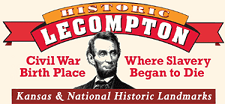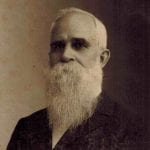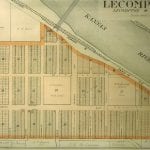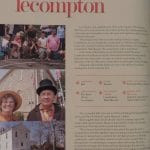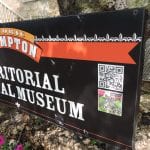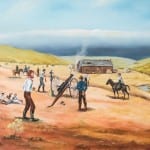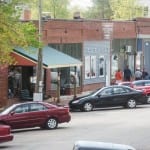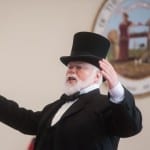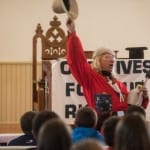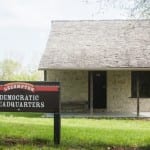[vc_row][vc_column width=”1/1″][text_output]Lane University & Territorial Capital Museum
Here is where the Kansas Capitol Building was to be built. This building was started with an appropriation of $50,000 from the United States Congress. It was completed to the bottom of the first floor windows when the United States House of Representatives defeated the Lecompton Constitution by only eight votes. (The U.S. Senate and President James Buchanan encouraged its adoption.) This meant that Kansas failed to enter the Union as a slave state with Lecompton as its capital.
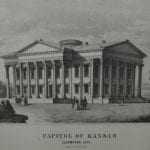
Drawing of the Proposed Capitol Building in Lecompton that was started, but never completed.
By early 1858, it was evident that Lecompton was not going to become the Kansas Capital and as the money had been spent, work on the capital ceased. At that time, the foundation for three wings had been laid, the center section had been completed up to the top of the first floor windows, and all the materials needed to complete the section, including four pillars, were laying on the ground.
It was in this shell that the Lecompton people attempted to stop James Lane from destroying the town in 1856. With the help of Camp Sackett Cavalry, they succeeded in stopping his assault. Lane was attempting to rescue the “to be” Governor, Charles Robinson from jail, as he had recently been tried for treason. He was acquitted, but was being held while certain legal formalities were completed.
It was also from here that the 13 stone masons who were working on the building picked up their guns and headed south on the Lecompton road to meet Col. Shombre and Captain Walker, in their projected attack on Lecompton. This was to be known as the Battle of Fort Titus.
The Territorial Capital Museum occupies what was once Lane University. The university was founded in 1865 by Rev. Solomon Weaver, the first president, and was named after U.S. Senator James H. Lane. Jim Lane was a main free-state leader, and Lecompton was previously the capital of the opposing pro-slavery faction. Local tradition notes that a funding drive to construct the university promised to name it after the major contributor. Allegedly, James H. Lane made the largest pledge, received the namesake honor, and then died of a self-inflicted gunshot wound before he could carry out his promise.
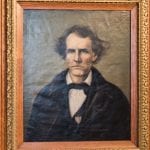
Lane University was named for James H. Lane. Portrait at the Territorial Capital Museum in Lecompton, Kansas.
The university was first located in what had been the Rowena Hotel, which was a three story stone structure built for the legislators to live in while in session. In 1865 the state donated to the university 13 acres of land that included the foundation of what had been intended to be the Kansas Territorial Capitol building at Lecompton. A college building was erected on the south half of the old foundation in 1882. The building had a self-supporting roof, architecturally unique in the area at that time. It was at this college that David J. Eisenhower and Ida Stover met and decided to marry. They later became the parents of Dwight D. Eisenhower, who was our 34th president.
The Church of the United Brethren in Christ owned and controlled the school during its entire history. Almost all of the presidents were pastors. In 1900 it had 11 faculty members and 178 enrolled students. In 1902 Lane University was united with Campbell University to form Campbell College (Kansas).
Today Lane University is a museum known as the Territorial Capital Museum, dedicated to Kansas history before the Civil War. It is listed on the National Register of Historic Places.
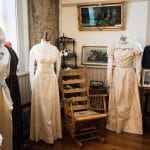
Lecompton history from the 1850’s to the present!
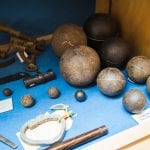
Pre-civil war artifacts, like these cannon balls from the Battle of Fort Titus at the Territorial Capital Museum in Lecompton.
The Territorial Capital Museum contains three floors of artifacts which include information from Pre Civil War Kansas through the Lane University period–and more.
To schedule a guided tour of the Territorial Capital Museum please call (785) 887-6148.
Hours: Wednesday – Saturday 11-4, Sunday 1-5. Monday and Tuesday visits are available-call ahead to schedule.
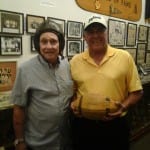
See the exhibit featuring local schools–plus the Lecompton Rural High School, in existence from 1902-1970.
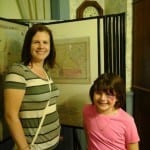
View our Territorial Kansas map exhibit, collection of maps from 1854-1861.
Tour-Shop-Eat
Make plans to visit Lecompton to tour both museums, shop at Lecompton boutiques, and eat at Lecompton eateries!
There are lots of things to do in Lecompton!
- The 1920 Junior Class pose in front of the old Lane U. building, which served as the Lecompton High School building until 1927.
- Lane University Professor Norman B. Bartlett . He was the President of Lane University from 1869-1902.
- Early Lecompton Map
- Article on Lecompton: One of the best small towns in Kansas!
- Finished project: a QR code next to the historic sites in Lecompton takes visitors to a video about the site.
- Battle of Fort Titus Reenactments
- Original painting of the Battle of Fort Titus by Ellen Duncan, at the Territorial Capital Museum in Lecompton, Kansas.
- Built in 1856, the Lecompton Constitution was drafted and signed in this building.
- Lecompton was voted a “best small town” in Kansas!
- Participate in town hall meetings with the Lecompton Reenactors.
- Participate in town hall meetings with the Lecompton Reenactors.
- Meetings took place here during Territorial times!
[/text_output][/vc_column][/vc_row]
